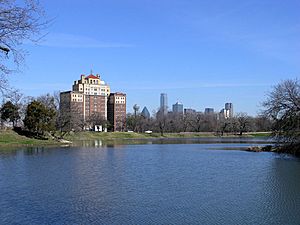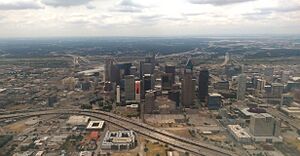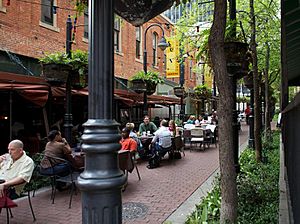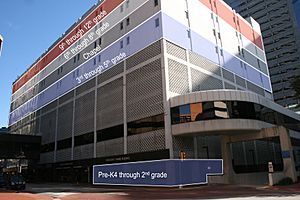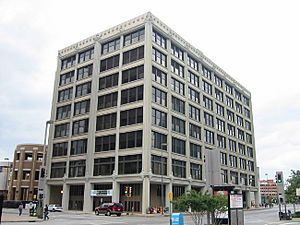Downtown Dallas facts for kids
Quick facts for kids
Dallas Central Business District
|
|
|---|---|
|
Central business district and residential area
|
|
| Downtown Dallas | |

Skyline of Downtown Dallas seen from Reunion Tower
|
|
| Nickname(s):
Big "D"
|
|

Location in Dallas
|
|
| Country | |
| State | |
| Counties | |
| City | |
| Area | |
| • Total | 3.63 km2 (1.4 sq mi) |
| • Land | 3.63 km2 (1.4 sq mi) |
| • Water | 0 km2 (0 sq mi) 0% |
| Elevation | 130 m (440 ft) |
| Population
(2017)
|
|
| • Total | 10,766 |
| • Density | 2,966/km2 (7,690/sq mi) |
| ZIP code |
75201, 75202, 75270
|
| Area codes | 214, 469, 972 |
Downtown Dallas is the main business area of Dallas, Texas, in the United States. It's right in the middle of the city. This area is the second-largest business district in Texas.
Traditionally, "Downtown" was seen as the area inside a freeway loop. This loop includes Interstate 345 to the east, I-35E to the west, I-30 to the south, and Woodall Rodgers Freeway to the north.
However, Downtown Dallas has grown a lot since the early 2000s. Now, the term "Downtown" includes 15 different areas. These new areas stretch beyond the original freeway loop. They include places like Victory Park and Uptown to the north. They also reach Deep Ellum to the east, the Cedars District to the south, and the Design District to the west. All these districts are connected and work together as part of Downtown Dallas.
Contents
History
Downtown Dallas became well-known on November 22, 1963. On that day, President John F. Kennedy was shot as his motorcade drove through Dealey Plaza. This area is now part of the West End Historic District. The Sixth Floor Museum at Dealey Plaza is located in the building where the shots came from. It has exhibits about President Kennedy and that day. Close by, you can also find the John Fitzgerald Kennedy Memorial.
In the 1970s and 1980s, many new buildings were constructed. These buildings gave the downtown skyline a modern look. At the same time, the West End Historic District was created. This helped save many old brick warehouses from the late 1800s. These old buildings are now used as restaurants and shops.
The Dallas Center for the Performing Arts is in the Arts District of Downtown. Dallas is special because it's the only city in the world with four buildings in one block designed by four different Pritzker Architecture Prize winners.
Expansion
Downtown Dallas has been changing a lot. Many old buildings are being turned into homes. Also, new high-rise apartment buildings are being built. This means more people are choosing to live in the downtown area. In 2017, about 10,766 people lived there.
The redeveloped Main Street has become a popular spot for people in Dallas. Many new restaurants, hotels, and residential towers have opened there. This growth is partly due to the Dallas Area Rapid Transit (DART) system. DART has four light rail lines and one commuter line, the Trinity Railway Express, that run through Downtown.
The city has also invested a lot of money to encourage development. It put $160 million of public money into downtown housing. This attracted $650 million from private investors.
Two new office buildings were started in 2005. This was the first time in over 20 years. One Arts Plaza is a 24-story building with offices, shops, and homes. It is now the world headquarters for 7-Eleven. The 17-story Hunt Consolidated office building is also downtown. It has cool LED lights on its outside. The Museum Tower is a 42-story residential skyscraper. It was finished in 2013.
The Trinity River Project is a big plan to change the Trinity River area. It will become a huge urban park. The park is expected to have an equestrian center, lakes, and trails. Three bridges designed by Santiago Calatrava are also planned. Even though getting money has been a challenge, work on the project is now moving forward. The first two bridges have received a lot of private support.
Culture
Downtown Dallas has seen many important changes. City officials believe these changes will make the city's center much better. These improvements are happening in four main areas: Victory Park, the Arts District, the Trinity River, and the Convention Center corridor.
Victory Park is a successful project that turned an old industrial area into a vibrant space. It is home to the American Airlines Center, built in 2001. Many new high-rise hotels, homes, and office buildings are also there. These include the "W Dallas Victory Hotel and Residences" and "The House" residential tower. The new Perot Museum of Nature and Science is also near Victory Park. It's a modern, 14-story building that opened in 2012.
The Dallas Arts District is already one of the largest in the world. It recently finished a huge 10-year building project. This project added a 2,300-seat opera house and several theaters. It also created new homes, shops, and parks. The tall, 42-story Museum Tower residential building opened here in 2013. The Dallas Museum of Art is another popular place in the Arts District.
The Trinity River Project is making the biggest changes in downtown Dallas. The river currently flows in a straight line far from downtown. But Dallas is working to return the river to its natural path. This will create two large lakes next to the downtown area. Two large cable-stayed bridges, like the Margaret Hunt Hill Bridge, are being built across the river and new lakes. Plans also include better levees to protect downtown from floods.
The Convention Center corridor is home to the large Dallas Convention Center. The Omni Dallas Hotel is a new, 23-story hotel for convention visitors that opened in 2011. Dallas hopes these changes will bring more people to live downtown. In 2010, the downtown population grew to 5,291 people. This is a big jump from about 1,000 people at the end of the 1900s.
The City of Dallas and other groups built a $110 million urban park over the Woodall Rodgers Freeway. This park, called Klyde Warren Park, opened in 2012. It connects the Uptown and Downtown areas. This 5.2-acre green space helps link the growing Uptown area with the busy Downtown Dallas Arts District. The park is often called an "urban oasis" because of its unique location and features.
Major employers
Many big companies have their main offices in Downtown Dallas. AT&T is headquartered at the Whitacre Tower. It moved to Dallas in 2008. Comerica has its headquarters in the Comerica Bank Tower. TM Advertising is also in the same building. Tenet Healthcare is headquartered in the Fountain Place building.
Belo and A. H. Belo have their main offices in the Belo Building. 7-Eleven's corporate headquarters are in the One Arts Plaza building. Energy Future Holdings Corporation is in the Energy Plaza complex. Greyhound Lines is located on North St. Paul Street. The Dallas Morning News also has its headquarters Downtown.
Neiman Marcus has its headquarters in One Neiman Square. The Trammell Crow Company is in the Trammell Crow Center. The KPMG Centre in Downtown Dallas has offices for KPMG and Sidley Austin. Which Wich? has its headquarters in Downtown Dallas. Deloitte has offices in the JPMorgan Chase Tower. Visitdallas, which helps bring tourists and conventions to the city, is also based downtown.
Neighborhoods
Within Loop
- Arts District
- City Center District
- Convention Center District
- Farmers Market District
- Government District
- Main Street District
- Reunion District
- West End Historic District
Outside Loop
- Trinity/Design District
- Victory Park
- Uptown
- State Thomas
- Bryan Place
- Baylor-Meadows
- Deep Ellum
- Fair Park
- Cedars
Tallest structures
- Bank of America Plaza - 921 feet (281 m)
- Renaissance Tower - 886 feet (270 m)
- Comerica Bank Tower - 787 feet (240 m)
- JPMorgan Chase Tower - 738 feet (225 m)
- Fountain Place - 720 feet (219 m)
- Trammell Crow Center 686 feet (209 m)
- 1700 Pacific 655 feet (200 m)
- Thanksgiving Tower 645 feet (197 m)
- Energy Plaza 629 feet (192 m)
- The Drever 628 feet (191 m)
Transportation
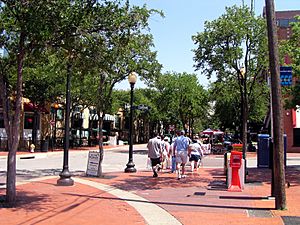
Downtown Dallas is surrounded by a major highway loop. This loop includes Spur 366 (Woodall Rodgers Freeway), Interstate 345, Interstate 30, and Interstate 35E. This loop is the center of Dallas's highway system, which looks like a wagon wheel with roads spreading out from the middle.
Downtown is also the main hub for the Dallas Area Rapid Transit (DART) light-rail system. The Blue and Red light-rail lines run through several stations downtown. The Trinity Railway Express commuter train connects Downtown Fort Worth with Downtown Dallas, ending at Union Station. Union Station also has Amtrak train service to other cities.
The McKinney Avenue Transit Authority runs the M-Line. This is a free trolley service. It travels from Uptown down St. Paul Street and loops around the West Village.
Greyhound Lines has a bus terminal at 205 South Lamar Street. DART also runs bus transfer centers downtown. The Denton County Transportation Authority has express commuter bus routes that serve stops in Denton, Lewisville, and Carrollton.
The Dallas Pedestrian Network is a system of walkways under Downtown Dallas. It covers 36 city blocks. This system connects buildings, parking garages, and parks using tunnels and skybridges above ground. It even has an underground area with shops, restaurants, and offices open during weekdays.
The Dallas CBD Vertiport is at the south end of the Convention Center. It is said to be the world's largest elevated heliport/vertiport. It can handle large aircraft like the Bell Boeing V-22 Osprey.
Media
Several media companies have their headquarters in Downtown Dallas. These include D Magazine, The Dallas Morning News, WFAA (a TV station), and KDFW (another TV station).
Education
Primary and secondary schools
Public schools
Downtown Dallas is served by the Dallas Independent School District.
Three schools are located right in the downtown area: Booker T. Washington High School for the Performing and Visual Arts, Dr. Wright L. Lassiter Jr. Early College High School at El Centro College, and the Pegasus School of Liberal Arts and Sciences.
Most of Downtown is zoned to Ben Milam Elementary School. A small part is zoned to Ignacio Zaragoza Elementary School. All downtown residents are zoned to Alex W. Spence Middle School and North Dallas High School.
Luna Academy, a charter school of Uplift Education, is also in Downtown Dallas.
Private school
Students can also attend First Baptist Academy of Dallas. This is a college preparatory school for Pre-K through 12th grade. It is located in the city center district of downtown. Holy Trinity Catholic School is another private school nearby. It offers early education through eighth grade.
Colleges and universities
El Centro College is part of the Dallas College system and is located downtown.
The University of North Texas, which is usually in Denton, has opened a law school downtown.
The University of Texas at Arlington, Texas A&M University-Commerce, and University of North Texas all offer degree programs at the Universities Center at Dallas. This center is also located downtown.
Parks and recreation
Pacific Plaza is a park that opened in 2019. It covers about 3.7 acres. The organization Parks for Downtown Dallas provided the money for this park. It replaced an empty area and is now a nice green space. A grand opening ceremony was held on October 14, 2019.


